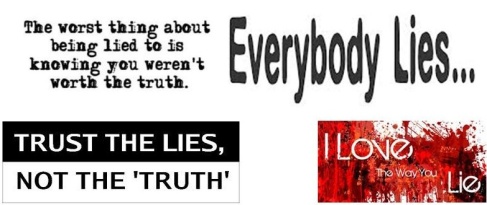“According to utilitarian theory, lying is good if it promotes a greater total amount of happiness (or the sum of the happiness experienced by the liar and the unhappiness experienced by his/her victims) than telling the truth. Lying is also good if it promotes a greater total amount of happiness for a greater number of people than telling the truth. The moral quality of lying is determined by the degree to which it promotes the greatest amount of pleasure or happiness for the greatest number of people.
. . .
“The liar as hero is a subject of ancient Greek mythology, in which a liar may be portrayed as both a hero and a scoundrel. Odysseus, for example, is a hero of Greek mythology who is a skillful liar and deceiver. . . .”
—Alex Scott, “The Morality of Lying and Deception”
http://philosophyreaders.blogspot.com.es/2013/03/the-morality-of-lying-and-deception.html
Too much abstraction leads not only to a sweeping generalization but also to a blatant universalization of the notion of the immorality of lying: The act of lying is malevolent, across the board. As a moral issue, the topic of lying has already reached a level of non-negotiable finality that precludes more serious and in-depth discussions. Lying, lies, liars . . . there is nothing good in them. With this pre-conceived idea in mind, talking about the value of lies is but an exercise in futility, much less, a stupid attempt to philosophize on an ethically “unredeemable” matter. Overwhelming public opinions have already univocally decided that lying is wrong, lies are malicious and liars are wicked.
But the human condition reveals otherwise. Lying is commonplace. Liars abound everywhere. Lies proliferate in a myriad of occasions here and there irrespective of context, intent and outcome. Because of lies, lying and liars, relationships are wrecked, circumstances are messed up, plans go awry, people are ruined, futures are devastated, hopes are spurned and lives are destroyed. In a wide range of instances, problems and troubles abound, both small- and large-scale, because of lies. This is the existential character of human reality: The real world where we live in is a world of lies inhabited by self-conscious entities with an unlimited propensity to lie.
Parallel to this reality, however, is the ideality of truth. Truth being the opposite of lie is what we desire. In this consideration, we are drawn once again to high-level abstraction with the rigid belief in the inalienable goodness of truth-telling versus the absolute immorality of lying. We are a vocal bunch calling for truth. We generally project the impression that we are incorruptible promoters of truth. We purposely stand up in public and openly express our strong advocacy of truth and vigorous defiance of falsehood, lies and distortion of veracity.
The truth of the matter is we humans are paradoxical creatures exalting truth on the one hand yet consciously committing lies on the other. Like Epimenides the Cretan, we find ourselves in a cycle of contradiction by hollering, “All Cretans are liars!” . . . If what he said was true, then he must be a liar; if what he said was false, then he was telling the truth.
But are all lies truly unilaterally destructive and hence malevolent? Is there not a single instance in human life wherein a lie has benefited the need of an individual person in a positive way, i.e., without harming others or without being detrimental to particular states of affairs? If we are decidedly convinced that all lies are evil and absolutely inimical to the human condition, then why does lying seem to be as natural as an inherent practice in certain human interactions? Why don´t we focus our attention on what realistically happens and concentrate our discussion within its limits?
High-level abstraction, though, is a habitual practice in classical philosophizing which in the process has the spontaneous predisposition to inadvertently dissociate conceptual discourse from existential groundwork. Thus, the challenge we are into at this point is for us to appropriate the issue of lies and lying in its actual state which is the existential location. The task at hand is therefore to correctly explore the occurrence of lies in real human experiences, their triggering factors and their equilateral effects in a variety of instances as we ourselves individually experience them and as we observe them being experienced by others.
The “politics”—i.e., the power structure—of human reality is characterized by benevolent and malevolent forces generated by the dynamics and mechanics of social interactive factors which challenge on the one hand and sustain on the other the more basic essentials of survival and the more advanced meaningfulness of human dignity. Unless we get seriously mindful of these matters, the inevitable course of life slides down to irrelevance, even to the extreme point of dehumanization as we are deprived of the necessary defences against the onslaught of vicious hostilities and aggressive assaults towards our very own humanity. This is the existential battleground where the imminence of decisiveness and action defines its own morality beyond the traditional and trivial conception of good and evil which spontaneously leads to what Nietzsche called “transvaluation of values”.
In the context of our present discussion on the value (or transvaluation, if you will) of lies, the existential determinant of its morality is therefore dependent on how we humans confront the forces of benevolence and malevolence. In this connection, lying may either be destructive or constructive. “Constructive lying” concurs so well with the benevolent forces and wages war against malevolence whereas “destructive lying” does the opposite. In this very process of existential transvaluation, we smash to smithereens and hence transcend the traditional myth that all lies are evil. In other words, there are very realistic instances in the human condition where lying becomes a benevolent act that sustains human flourishing through (1) relief from suffering; (2) resolution of conflict; and (3) promotion of wellbeing.
An oft-cited example is in a situation of large-scale conflict as in a war where a POW being interrogated by the enemy in a prison camp is not supposed to tell the truth even to the point of death as to information leading to tracing the whereabouts of his comrades. Lying to criminal elements on matters that if truth is revealed, the situation of innocent people would be in serious jeopardy is another instance. In less grave circumstances but would still put into a risky situation another person if truth is told, a “constructive lie” is appreciable as long as in the issuance of it, no collateral damage would be generated towards other people, much less, those who are not originally and directly involved in the problem on a wider scope.
Other types of lies are likewise deemed constructive when uttered as a defensive stance in cases where the issue of personal survival is at stake, but again, with the caveat that such would not necessarily create collateral damages to innocent people anywhere and anytime. This particular consideration is in acknowledgment of the fact that every individual has certain jealously guarded secrets that must not be publicly revealed. Otherwise, the possibility of weakening the fibre of his personal dignity would be severely affected and at worst damaged. But an inevitable circumstance could unexpectedly occur at the most inconvenient time and a most jealously guarded secret could unwittingly be put on the spot and inadvertently challenged. This is a particular instance where a constructive lie works without generating damage to anybody much less to one´s very own self.
In the utilization of constructive lies purposely (1) to preserve the worth of one´s person, (2) to sustain and strengthen order in human interaction when destructive forces dare and jeopardize it and (3) to achieve better conditions in life when truth becomes aggressively ruthless and existentially out of hand, the one and only caveat emptor is that this type of lies must absolutely not in any way cause harmful effects to other people as well as to events both foreseeable and unforeseeable anywhere and anytime.
Contrary to constructive lies are of course the destructive ones. These are lies sustained and in turn further strengthen the clout of malevolent forces in human interaction. Their sole intent is to wreck relationships, mess up circumstances, obliterate plans and ruin people. These are the lies that originally and unilaterally conditioned our minds to think across the board that all lies are immoral.
With the transvaluation that we have so far done on the issue of lies, something has been made clear in our broadened consciousness. In this very process, we have been able to categorize lies as either constructive or destructive and while focusing now our attention more on the destructive variety, the same abhorrence remains: Lies of the nefarious type are and will always be evil.
© Ruel F. Pepa, 29 January 2014





